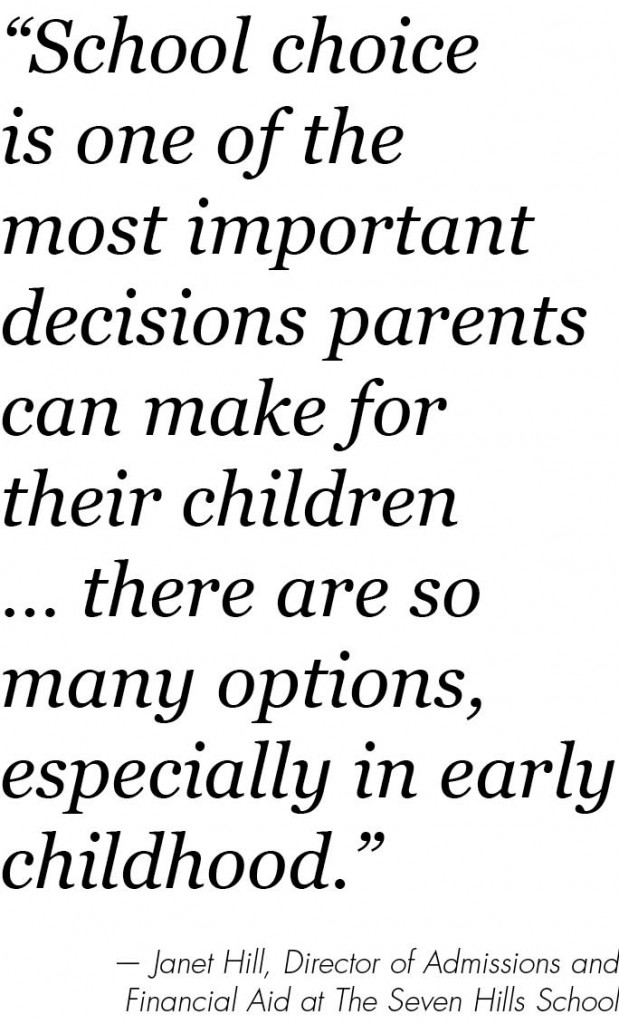Your struggle to choose between public and private school is over. Now a new issue arises: which private school is right for your child? Groups like the National Association of Independent Schools and others offer useful materials, but we’ve done some homework for you. Here’s what to look into before you go any further.
Start Now
Janet Hill, Director of Admissions and Financial Aid at The Seven Hills School, says, “School choice is one of the most important decisions parents can make for their children … there are so many options, especially at early childhood.”
Admissions offices typically work about a year in advance of actual enrollment. Schools usually have deadlines posted on their web sites, or you can pick up a school calendar during your site visit. According to the National Association of Independent Schools (NAIS), most schools accept applications in December, January and February, and make admissions decisions in April and May for the following August or September. Some schools will also accept applications on a rolling admission basis if space permits.
 If you’re looking into a school that is particularly competitive, it might be wise to make contact even sooner. According to Aaron Kellenberger, Director of Admission at Cincinnati Country Day School, space is always an issue. He advises parents to learn a school’s admission process, and to be aware of special dates and deadlines, and adds that it’s not unusual for him to take calls from parents who are actually still expecting! And The Montessori School at The Summit Country Day School is what Kelley Schiess, Assistant Head of School for Enrollment Management, calls “a prime entry point,” but she adds that space is very limited. The Summit has several different deadlines for The Montessori School, according to Schiess, who advises parents to visit the website for the complete schedule.
If you’re looking into a school that is particularly competitive, it might be wise to make contact even sooner. According to Aaron Kellenberger, Director of Admission at Cincinnati Country Day School, space is always an issue. He advises parents to learn a school’s admission process, and to be aware of special dates and deadlines, and adds that it’s not unusual for him to take calls from parents who are actually still expecting! And The Montessori School at The Summit Country Day School is what Kelley Schiess, Assistant Head of School for Enrollment Management, calls “a prime entry point,” but she adds that space is very limited. The Summit has several different deadlines for The Montessori School, according to Schiess, who advises parents to visit the website for the complete schedule.
Identify Matches
Traditional or progressive? Small or large? Half-day or full-day for preschoolers? Draw up a list of desirable qualities in order to rate your prospective schools, including education styles.
“Over and over again we hear from parents who have been here for a year that they are happy with not just what their kids are learning, but how they learn it,” says Hill, explaining that The Seven Hills School focuses on a hands-on atmosphere and the process of learning. She advises parents to also consider some of the following factors: a diverse learning experience, including academics, extra-curricular activities, community services, and a diverse student body; average class size and teacher-to-student ratio; a challenging curriculum, especially for older students; extra-curricular opportunities; and a strong sense of community within the school. “We’re very proud of our community,” she says, adding that The Seven Hills School prizes their partnership with parents. “We are like an extension of your family.”
Schiess suggests that parents ask questions about accreditation (and by who), how students are evaluated, opportunities for parents to be involved, and the possibility of you sitting in on a class or your child shadowing a student for a day. It also helps to ask about student outcomes. “Recently, 100 percent of our 97 graduates were accepted to colleges and universities across the country and abroad, and were awarded $24.9 million in merit scholarship awards,” she says.
Kellenberger says that most parents who visit Cincinnati Country Day School want to know about curriculum and the school’s educational philosophy first. But he also tries to share what he calls “the routine of the classroom” and give parents a picture of how their child will spend their day. “Parents are focused on the whole child,” he says, adding that parents want to know about the teachers, but they also want to know about opportunities in art, music, the outdoors. He also says that he’s starting to notice an increase in questions about nutrition — what kinds of snacks and lunches are served, and what are the school’s policies when it comes to food allergies.
Due Diligence
Open houses are great, but visiting a classroom in action is critical, according to Kellenberger, especially with very young children. “You can’t find fit from looking at a screen or a brochure,” he says. At Cincinnati Country Day School, parents bring their tots to a classroom for about 30 minutes, divided into 15 minutes of one-on-one time with a teacher, and 15 minutes of “free time” to let the child explore. This gives teachers a chance to see how well your child can separate from you, and to see what activities draw his attention. The school also likes to talk with parents about other influences at home, like older siblings, and parenting philosophies to get a better feel for how your family works. “We really believe that this will be a family experience,” says Kellenberger, adding that the school’s most successful students are the ones who are part of a strong relationship between the parents and the school.
Interviews of older prospective students aren’t quite “interviews,” according to our sources. Kellenberger says they’re a non-pressure opportunity for kids to talk about how they liked their school visit, and to ask questions of their own. Hill refers to these chats as just an easy conversation to get to know the child. And Schiess says that a meeting with the child is a great opportunity for faculty and admission staff to learn about the child’s interests and share the school’s programs. “Parents don’t need to prepare their children for these interviews,” she says. “Parents should approach the interview with their children as an exciting learning opportunity.”
Your interviews with school administrators are going to be crucial in determining whether a school is right for your child, but mine other sources for information, too. Seek out parents who have children enrolled at the schools you like and get real-world answers to your questions. A number of points of view will help you make a decision. Keep a log of your contact with various schools, know names, be courteous and mindful of timing.
Brass Tactics
Annual tuition ranges from about $3,000 for early childhood programs and increase from there for secondary grades. But the good news is that most schools offer some form of financial aid or tuition scholarships, and you can explore financing options with them. You’ll want to be mindful of ancillary expenses such as uniforms, laptops, sports equipment, books, supplies and school trip fees when determining costs per year.
Keep It Real
A school’s name, recognition and reputation within your community might play a role in your final choice, but it should really only be a small part. At the end of the day, it’s all about finding the school where your child’s most comfortable, the school that understands your family’s needs and goals, and also makes you feel like you’re a crucial part in your child’s education. It’s a team effort, after all.





